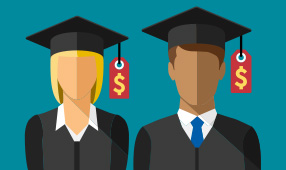Wondering if it makes financial sense to refinance your student loans? Three in 10 borrowers say they’ve either consolidated or refinanced their student loan debt. According to the most recent data available, the average amount of student debt adds up to $37,900 for most college graduates.
There can be sensible reasons to refinance, but there are also wise reasons not to do so. That’s why it’s so important to fully evaluate the potential advantages and drawbacks.
Your goals should be:
- To determine whether refinancing will save you enough money to make the process worthwhile
- To ensure you won’t be giving up valuable benefits associated with your current loan programs
The NEA Student Debt Navigator, our free online student loan evaluation tool, can help you quickly see what options you may have for student loan debt reduction or forgiveness.
3 reasons you shouldn’t refinance your student loans
First, let’s assess some scenarios in which refinancing may not be the best choice:
1. You may qualify for federal loan forgiveness programs.
If you refinance a federal loan into a private loan, you’re no longer eligible for federal loan forgiveness, and you may also forfeit deferment and forbearance options. That’s an important distinction if you’re a public-school educator, because you may qualify for partial or entire forgiveness of your federal student loans through Teacher Loan Forgiveness, Public Service Loan Forgiveness or Teacher Loan Cancellation.
The NEA Student Debt Navigator can help easily and accurately assess whether you qualify for free federal forgiveness programs, depending on your current situation.
In addition, almost every state offers a forgiveness program—and many have several, typically requiring work in an underserved community or profession for a certain number of years.
2. You’re interested in a repayment plan based on income.
If you have federal student loans, you may qualify for an income-driven repayment plan that sets your monthly payment based on a percentage of your income and family size. Private student loans don’t offer income-driven repayment plans.
Four plans apply to federal student loans:
- The new Saving on a Valuable Education (SAVE) plan has replaced the Revised Pay as You Earn (REPAYE) plan, and those enrolled in the earlier plan were automatically transferred. In February 2024, President Biden announced that nearly 153,000 borrowers in the SAVE plan will have $1.2 billion in student loan debt canceled and those affected would receive an email informing them.
- Revised Pay As You Earn Repayment Plan
- Pay As You Earn Repayment Plan
- Income-Based Repayment Plan
- Income-Contingent Repayment Plan
Under these options, you may qualify for lower payments—or even be able to defer payments until you’re more financially stable.
The NEA Student Debt Navigator, powered by Savi, can help you assess your repayment plan options.
3. You’re still in school or in the grace period before loan payments begin.
If you’re just graduating and decide to refinance federal student loans, you may give up the automatic grace period that applies to most types of direct, subsidized loans. Uncle Sam also picks up the interest on subsidized loans while you’re enrolled in school or in the grace period. After you graduate, leave school or drop below half-time enrollment, you have a six-month grace period before you must start making payments. That means if you graduate in May, the initial payment is due in November.
That period of time can be important, because it gives you a chance to begin a job, get financially settled and choose your repayment plan. Note that private loans begin accruing interest as soon as the funds are disbursed, and they may not have guaranteed grace periods.
3 reasons you should consider refinancing your student loans
If none of those scenarios above describes your situation, then review these reasons for when refinancing may be a good option:
1. You have multiple, private student loans with various rates and payment schedules.
When you have private loans, locking in lower interest rates could save you money and allow you to pay them off faster. Say you have a $30,000 loan at a 6% fixed interest rate for 10 years. Over the life of the loan, you’d pay $9,967 in interest along with your $333 monthly payment. If you refinanced at a lower interest rate of 4.75%, you’d pay $7,745.19 in interest, which would save you $2,222.19 over the life of the loan.
What’s more, refinancing multiple loans from several lenders consolidates them into one loan—with a single interest rate, monthly payment and due date. Besides reducing the chances of missing payments and incurring late fees, refinancing can help simplify your budget.
2. You have stable employment, reliable income and good credit.
When Allie K. graduated with a bachelor’s degree in early childhood education and special education a few years ago, she had amassed $50,000 in private student loans with interest rates that ranged from 12% to 16%, plus an additional $25,000 in federal loans.
“My total monthly payment was enormous,” she recalls. “I knew I had to get a good job immediately so I could start paying off the loans, but I also knew there had to be a way to lower my payments and get better terms once I did.”
Employed as a third-grade teacher in Virginia, Allie focused on building a solid credit score, saving what she could and exploring refinancing options. Eventually she refinanced her high-interest loans into one loan with a 6% interest rate, which lowered her monthly payments substantially. She also was able to reduce the repayment term from 20 years down to 10 years so she can pay off the debt sooner.
3. You want more flexibility and autonomy in your loan terms.
Private student loan lenders offer the choice of fixed or variable interest rates, while rates on federal student loans are fixed. (Fixed interest rates stay the same for the duration of your loan; variable interest rates fluctuate with the market.) Depending on your situation, one option may be more favorable than the other.
When refinancing existing loans, the goal is often to secure a lower interest rate. Fixed rates lock in a consistent rate and variable rate choices take advantage of the fluctuations—now or in the future. Some private lenders also allow you to adjust your payment due date whenever you like. In addition, private lenders may also have a wider range of flexible loan terms.
With the NEA Student Loan Refinance Program through College Ave, for example, borrowers have a choice of several different loan terms, ranging from five to 15 years.
And if you had a co-signer (a parent or family member, for example) on your student loans during college, you may now qualify to refinance in your name only to remove your co-signer’s obligation on your existing loans.
Research your options, and check your membership benefits
When it comes to student loan refinancing, there is no one-size-fits-all answer. Before you decide, weigh the pros and cons and then check to see if it really works for your circumstances.
You can use the DOE’s loan simulator to find a repayment plan that meets your needs or try College Ave’s student loan refinance calculator to see what you’ll owe and what you’ll save in total based on various types of refinancing plans.
And you can learn more about the flexible NEA Student Loan Refinance Program, which offers a special one-time statement credit equaling 0.5% of the loan1 and an additional interest rate discount to NEA members who enroll in autopay2.
1. Amount equal to 0.5% of the initial loan balance to be credited on the borrowers statement within 60 days of closing of the loan. For example, if the consolidated loan equaled $20,000, the member benefit equals $100, with a maximum of $599.99.
2. The 0.25% auto-pay interest rate reduction applies as long as the borrower or cosigner, if applicable, enrolls in auto-pay and authorizes our loan servicer to automatically deduct your monthly payments from a valid bank account via Automated Clearing House (“ACH”). The rate reduction applies for as long as the monthly payment amount is successfully deducted from the designated bank account and is suspended during periods of forbearance and certain deferments. Variable rates may increase after consummation.









